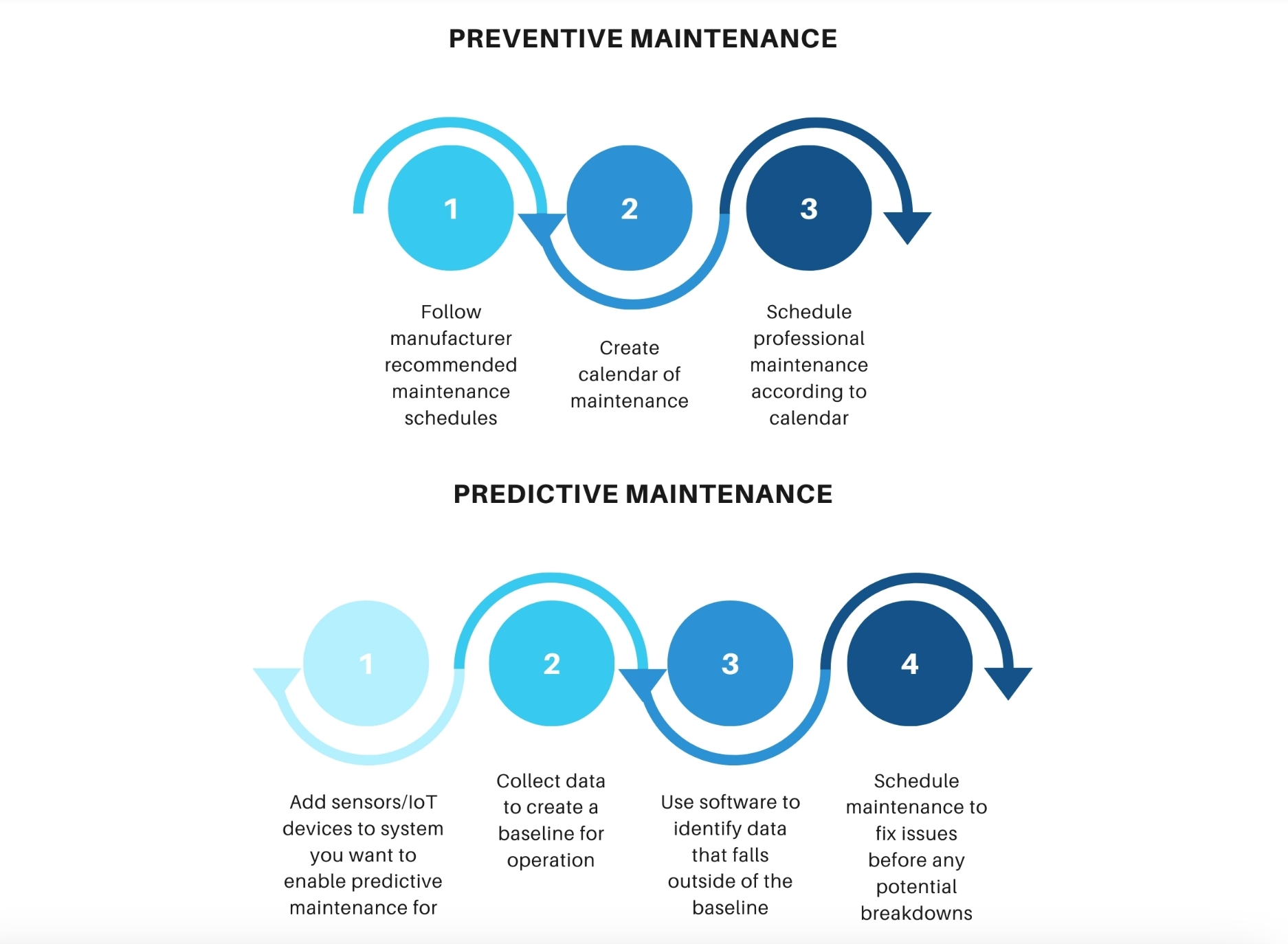In an age where technology is reshaping every facet of business, commercial real estate (CRE) is experiencing a paradigm shift in building management. The introduction of predictive maintenance software represents a significant milestone in this transformation, offering a sophisticated approach to facility management that transcends traditional methods. By integrating cutting-edge technology into everyday operations, CRE professionals can harness the full potential of their investments and set new standards in building efficiency and tenant satisfaction.
Grasping predictive maintenance software in commercial real estate
Predictive maintenance stands out as a revolutionary approach that utilizes various data sources and advanced analytics to predict equipment failures before they happen. By leveraging such software, property managers can:
- Anticipate potential issues
- Schedule convenient maintenance
- Avoid the unexpected downtime that often comes with traditional maintenance approaches
Integrated sensors, Internet of Things (IoT) devices, and a robust data processing framework power predictive maintenance. The software analyzes data trends to forecast equipment malfunctions using condition assessments. This allows for timely interventions that can significantly extend the life of a building’s critical systems.
What is the difference compared to preventive maintenance?
While predictive maintenance might seem similar to preventive maintenance, the two are distinct in their approach to building care. Preventive maintenance is scheduled based on time or usage intervals, irrespective of the actual condition of the equipment. It operates on a set routine, such as servicing an air conditioning unit every six months, which can be cost-effective and reliable.
In contrast, predictive maintenance is condition-based and relies heavily on data to inform maintenance actions. Instead of following a fixed schedule, maintenance tasks are performed when the software indicates they are necessary. This data-driven approach optimizes the timing of maintenance activities. Still, both require efficient work order management to schedule repairs.
How predictive analytics enhance building maintenance
The application of predictive analytics to building maintenance represents a significant leap forward from traditional methods. Traditionally, maintenance relied on a combination of manufacturer-recommended maintenance and reactive fixes. Predictive analytics offers a more nuanced approach, capable of detecting subtle patterns and anomalies that human operators may overlook. This allows for a more precise maintenance schedule and helps identify the root causes of potential problems before they manifest into costly repairs.
Key advantages of predictive maintenance for CRE properties
Shifting to predictive maintenance brings with it a whole slew of advantages, namely:
- Cost efficiency: Predictive maintenance can lead to substantial cost savings by addressing problems before they escalate into major failures.
- Asset life extension: Using predictive maintenance to regularly service equipment based on its condition can extend the life of building systems by up to 40%, according to Nucleus Research.
- Energy efficiency: Predictive maintenance can optimize the performance of systems like demand-controlled ventilation and lighting, leading to reduced energy consumption and a smaller carbon footprint.
- Tenant satisfaction: By avoiding unexpected outages and maintaining a consistent environment, predictive maintenance helps keep tenants comfortable and potentially justifies higher lease rates.
AI-driven diagnostics and prognostics
AI-driven diagnostics refers to the ability of systems to analyze data and identify existing faults in building systems. At the same time, AI-driven prognostics predict the future state of those systems, estimating when they will require maintenance or replacement.
Enhancing predictive maintenance with AI technology
Integrating AI technology into predictive maintenance systems brings more accuracy and foresight to the maintenance process. Here are a few specific ways AI technology can enhance predictive maintenance:
- Advanced pattern recognition: AI algorithms excel at detecting complex patterns within large datasets that human analysis could miss. This capability allows for the early identification of signs that precede equipment failure.
- Anomaly detection: Continuously monitoring for deviations from normal operation enables AI systems to instantly flag issues that could lead to potential failures giving you ample time to address the issue.
- Automated root cause analysis: Automating the root cause analysis of equipment malfunctions leads to more effective and long-term maintenance solutions as it removes the need for band-aid fixes.
- Predictive analytics: By combining historical data with real-time input, AI can forecast future equipment failures with high confidence, allowing for preemptive maintenance actions.
How to best use AI in modern maintenance strategies
Below are a few of the best practices for using AI in modern maintenance strategies:
- Data quality and quantity: Ensuring high-quality, relevant, and substantial data is crucial for accurate AI-driven diagnostics and prognostics.
- Integrate with IoT devices: Integrating AI with a robust network of IoT sensors maximizes its maintenance capabilities and understanding of baseline conditions.
- Continuous improvement: AI models should be continuously updated and refined to adapt to the changing conditions of building systems and maintenance needs.
- Vendor selection: Choosing the right AI predictive maintenance software requires careful consideration. Collaborating with vendors offering robust support and a proven track record in the industry is important.
Evaluating your needs and choosing the right software
For commercial real estate (CRE) professionals, the decision to implement predictive maintenance software is a strategic one that can significantly impact their properties’ operational efficiency and profitability. However, selecting the right software requires a clear understanding of the property’s maintenance needs. Then, you need to assess how different software solutions can meet these needs.
Integrating predictive maintenance into your existing systems
The first step toward integrating predictive maintenance into your existing systems is to evaluate your current maintenance operations. This evaluation should help you identify the strengths and limitations of your current approach and set clear objectives for what you want to achieve with predictive maintenance. Key considerations include:
- Compatibility: Ensure the chosen software can integrate seamlessly with your existing building management systems and IoT devices.
- Scalability: Consider whether the software can scale up as your property portfolio grows or as you add more devices and data points.
- Usability: The software should be user-friendly, enabling your team to adopt it with minimal training.
- Functionality: Identify the specific features you need, such as real-time monitoring, alert systems, and detailed analytics.
- Cost: Assess the software’s pricing structure to ensure it aligns with your budget and provides a good return on investment.
- Support: Look for a vendor with robust customer support, including training, troubleshooting, and regular updates.
Once you’ve defined your needs, you can research and compare different predictive maintenance software solutions. Look for case studies or testimonials from other CRE professionals to understand how each software performs in real-world scenarios.
Leveraging ProptechOS for enhanced effect and the best possible overview
With ProptechOS as your building’s operating system, you can integrate your predictive maintenance software with your other software. This allows you to leverage all of your real estate data within your predictive maintenance analytics. It also lets you automate reactions based on your predictive maintenance results. For example, you can send recommendations from your predictive maintenance to ProptechOS partners like Granlund Manager to schedule necessary fixes.
To leverage ProptechOS effectively, follow these best practices:
- Conduct a pilot test: Start with a pilot project on a small scale to evaluate the platform’s effectiveness before a full rollout.
- Train your team: Invest in training for your staff to ensure they can use ProptechOS to its full potential.
- Integrate gradually: Integrate the platform with your existing systems gradually to manage the transition smoothly and effectively.
- Use the data: Actively use the data and insights provided by ProptechOS to inform your maintenance decisions.
You can get started with ProptechOS for free today to conduct your pilot test without any investment or commitment. This will let your team explore the ProptechOS platform and see how it can help improve your operational efficiency.

Dr. Erik Wallin
Chief Ecosystem Officer, and founder of ProptechOS and RealEstateCore is recognized as a leader in Building Operating Systems (BOS) and making the buildings of the world smarter. He holds an MSc and a Ph.D. in Media and Computer Science from KTH Royal Institute of Technology.
Read his full bio and information here.


